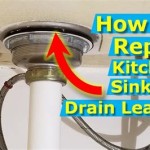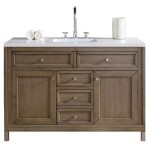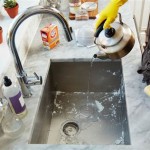How To Fix A Pipe Leak Under the Kitchen Sink
A leaking pipe under the kitchen sink can be a nuisance and, if ignored, can lead to more significant problems like water damage, mold growth, and wasted water. Addressing the leak promptly is crucial to minimize potential damage and save on repair costs. This article offers a comprehensive guide on how to identify, diagnose, and fix a pipe leak under the kitchen sink, empowering homeowners to tackle this common plumbing issue.
Before commencing any repairs, several preliminary steps are essential for safety and a successful outcome. These include gathering necessary tools and materials, identifying the source of the leak, and shutting off the water supply.
Preparing for the Repair
Prior to initiating any plumbing repair, gathering the required tools and materials is a crucial step. This ensures a streamlined and efficient process, minimizing downtime and frustration. Essential tools commonly needed for under-sink pipe repairs include:
- Adjustable wrench: Provides leverage for loosening and tightening nuts and fittings of various sizes.
- Pipe wrench: Offers added grip for working with larger pipes, particularly metal ones.
- Plumber's tape (Teflon tape): Used to seal threaded connections and prevent leaks.
- Plumber's putty: A pliable sealant used to create watertight seals around fittings and connections.
- Bucket: To collect any residual water from the pipes when disassembled.
- Towels or rags: For mopping up spills and drying surfaces.
- Screwdrivers (Phillips and flathead): May be required for removing or tightening clamps and screws.
- Gloves: Protect hands from dirt, grime, and potential contaminants.
- Safety glasses: Protect eyes from splashing water or debris.
- Flashlight or headlamp: To improve visibility in the often dark space under the sink.
In addition to tools, having replacement parts readily available is advantageous. Common replacement parts for under-sink plumbing include:
- P-trap: The curved pipe that traps debris and prevents sewer gases from entering the house.
- Slip nuts and washers: Used to connect pipes to fittings and create watertight seals.
- Tailpiece extension: A straight pipe section used to extend the length of the drainpipe.
- Drainpipes: The various pipes that carry water away from the sink.
Before starting any work on the plumbing, identifying the precise location of the leak is paramount. This will help in determining the necessary repair procedure and prevent unnecessary disassembly of other components. Carefully inspect all pipes, connections, and fittings under the sink, looking for signs of water droplets, moisture, or mineral deposits. Pay close attention to the following areas:
- Pipe joints: Where two pipes are connected together.
- Fittings: Including elbows, tees, and couplings.
- P-trap: The curved section of pipe beneath the sink.
- Faucet connections: Where the water supply lines connect to the faucet.
- Garbage disposal connections: If a garbage disposal is installed, check all its connections.
Once the leak source has been located, taking photographs or making a detailed sketch of the pipe configuration can be helpful, especially if extensive disassembly is required. This will assist in reassembling the plumbing correctly.
The most important step before commencing any plumbing repair is to shut off the water supply to the kitchen sink. This prevents water from flowing into the pipes while you are working, avoiding flooding and potential damage. Locate the shut-off valves under the sink, which are usually small, oval-shaped handles. Turn both the hot and cold water valves clockwise until they are fully closed. After shutting off the water, turn on the kitchen faucet to relieve any residual pressure in the pipes.
Diagnosing the Leak
After preparing for the repair, a more detailed diagnosis of the leak is necessary to determine the appropriate course of action. Different types of leaks require different solutions. Common causes of leaks beneath the kitchen sink include loose connections, corroded pipes, and damaged fittings. A visual inspection is often the most effective method for identifying the underlying problem.
Loose connections are a frequent cause of leaks under the kitchen sink. These connections are typically secured with slip nuts, which can loosen over time due to vibration or temperature changes. To check for loose connections, carefully tighten the slip nuts using an adjustable wrench. Avoid overtightening, as this can damage the nut or the pipe. If a leak persists after tightening the nut, consider replacing the washer inside the connection. The washer may be worn or cracked, preventing a watertight seal.
Corrosion can weaken pipes and fittings, leading to leaks. Corrosion is more common in older plumbing systems made of metal pipes, such as galvanized steel or copper. To inspect for corrosion, examine the pipes and fittings for signs of rust, pitting, or discoloration. If corrosion is present, the affected pipes or fittings will likely need to be replaced. In severe cases, the entire plumbing system may need to be upgraded to more durable materials, such as PVC or PEX.
Cracks and breaks in pipes or fittings can also cause leaks. These damages can be caused by physical impact, freezing temperatures, or general wear and tear. To check for cracks and breaks, carefully examine the pipes and fittings for any visible signs of damage. If a crack or break is found, the damaged section of pipe or the entire fitting will need to be replaced. If the damage is minor, a temporary repair using plumber's tape or epoxy putty may be possible, but a permanent replacement is recommended as soon as possible.
The P-trap is a curved section of pipe designed to trap debris and prevent sewer gases from entering the house. Leaks can occur at the connections between the P-trap and the drainpipes. To check for leaks in the P-trap, inspect the slip nuts and washers at both ends of the trap. Tighten the nuts if they are loose, and replace the washers if they are worn or cracked. If the P-trap itself is damaged, it will need to be replaced.
Faucet connections are another potential source of leaks. The water supply lines connect to the faucet using compression fittings, which can loosen over time. To check for leaks at the faucet connections, tighten the compression nuts using an adjustable wrench. Be careful not to overtighten, as this can damage the fitting or the faucet. If the leak persists, consider replacing the compression washers or the water supply lines themselves.
If a garbage disposal is installed, check the connections between the disposal and the drainpipes for leaks. Garbage disposals can vibrate and loosen connections over time. Tighten the slip nuts and screws that secure the disposal to the drainpipes. If the leak continues, consider replacing the rubber gasket between the disposal and the sink flange. This gasket can deteriorate over time and cause leaks.
Repairing the Leak
Once the source of the leak and its underlying cause have been determined, the repair process can begin. The specific repair method will depend on the nature of the leak. Common repair techniques include tightening connections, replacing washers, applying plumber's tape or putty, and replacing damaged pipes or fittings.
For leaks caused by loose connections, simply tightening the slip nuts or compression nuts may be sufficient. Use an adjustable wrench to tighten the nuts, turning them clockwise until they are snug. Avoid overtightening, as this can damage the nut or the pipe. After tightening the nuts, turn the water supply back on and check for leaks. If the leak persists, proceed to the next step.
If tightening the connection does not stop the leak, the washer inside the connection may be worn or cracked. Turn off the water supply again and disconnect the pipe at the leaky connection. Remove the old washer and inspect it for damage. Replace the old washer with a new washer of the same size and type. Reconnect the pipe and tighten the nut. Turn the water supply back on and check for leaks.
Plumber's tape, also known as Teflon tape, can be used to seal threaded connections and prevent leaks. Wrap plumber's tape around the threads of the pipe fitting before connecting it to the other pipe or fitting. Wrap the tape in a clockwise direction, overlapping each layer slightly. Apply several layers of tape to ensure a good seal. Tighten the connection securely. Plumber's putty can be used to seal around fittings and connections, such as the base of the faucet or the drain flange. Apply a bead of putty around the fitting before installing it. Press the fitting into place and remove any excess putty. Plumber's putty is not suitable for sealing pressurized pipes.
If a pipe or fitting is damaged, it needs to be replaced. Turn off the water supply and disconnect the damaged pipe or fitting. Measure the length of the damaged pipe or fitting and purchase a replacement of the same size and type. If replacing a section of pipe, cut the pipe to the correct length using a pipe cutter or a hacksaw. Deburr the cut ends of the pipe to remove any sharp edges. Connect the new pipe or fitting to the existing plumbing using appropriate fittings and connectors. Use plumber's tape or putty to seal the connections. Tighten all connections securely. Turn the water supply back on and check for leaks.
After completing the repair, thoroughly inspect the area under the sink for any remaining leaks. Dry any wet surfaces with a towel or rag. Monitor the repaired area for several days to ensure that the leak is completely resolved. If any leaks reappear, repeat the repair process.
If the homeowner is uncomfortable performing any of these steps, or if the leak is complex or persistent, it is advisable to call a qualified plumber. A professional plumber has the knowledge, experience, and tools to diagnose and repair plumbing problems accurately and efficiently. Attempting to fix a plumbing problem without the necessary expertise can lead to further damage and higher repair costs.

4 Simple Ways To Fix A Leaky Sink Drain Pipe Wikihow

How To Fix Kitchen Sink P Trap Leaking Pipe Connection Nut

How To Fix Or Replace A Leaky Sink Trap Hometips

How To Replace A Kitchen Sink Drain Strainer Repair Leak

4 Ways To Fix Your Kitchen Sink Wikihow

How To Find A Leak Under The Kitchen Sink Legacy Plumbing

4 Simple Ways To Fix A Leaky Sink Drain Pipe Wikihow

Quick Tip For A Kitchen Sink Drain That Is Leaking

How To Repair A Leaking Sink Trap

How To Find And Repair Hidden Plumbing Leaks Family Handyman







